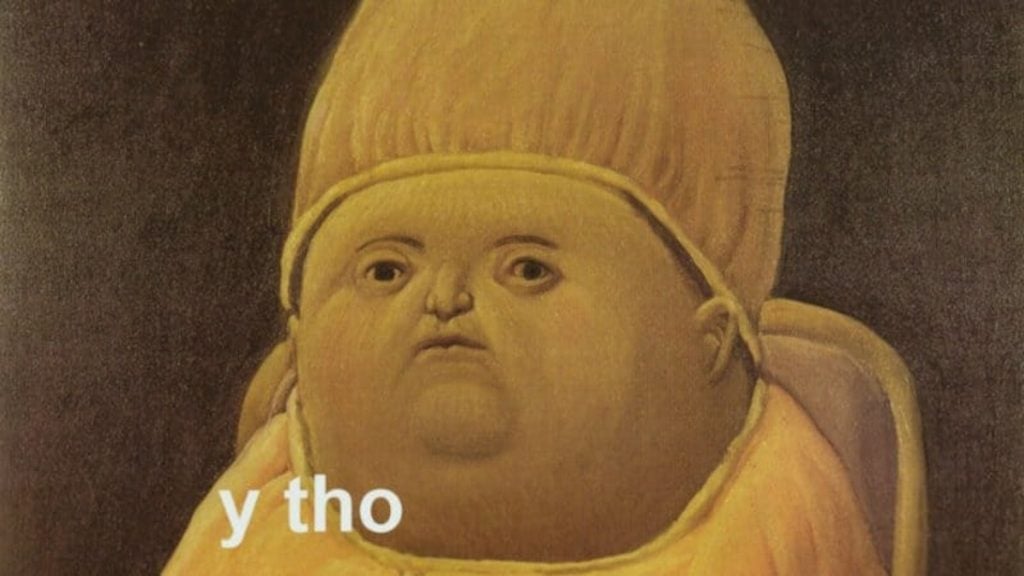Pop Culture
Art Behind the Meme: Fernando Botero’s ‘Baby’ Pope
The late Colombian artist made his name creating plump caricatures of famous paintings and people.

The late Colombian artist made his name creating plump caricatures of famous paintings and people.

Tim Brinkhof

Between 1518 and 1520, Pope Leo X sat for a portrait by the Renaissance master Raphael. A lifelong patron of the arts, he wished for this dignified painting, which shows him dressed in his papal garb and seated in front of an illuminated manuscript of the Bible with a magnifying glass in hand, to become the image future generations would remember him by.
For several centuries, it was—until, in 1964, it was dethroned by another portrait painting, one that depicts the pope in a less flattering light. Pope Leo X (after Raphael), the work of Colombian artist Fernando Botero, has little in common with Raphael’s original. Where the latter portrays Leo X in a realistic albeit idealized style, Botero’s version is an uncanny fusion between an adult and an infant, with short, stocky limbs, a large, round face, and microscopic facial features.
Sometimes called “Baby Pope,” Botero’s Pope Leo X (after Raphael) became an instant meme when it was uploaded to a Reddit forum in 2014. Frequently accompanied by the phrase “Y tho” (an abbreviation of “why though”), the painting is used as a response to seemingly absurd or pointless situations and actions. You could even use it to ask why Botero would take a perfectly good painting by Raphael and transform it into… whatever it is we ended up with.
RIP Fernando Botero – acclaimed artist in the Primitivism style and creator of "Pope Leo X (after Raphael) – 1964"
which happens to be the foundation of the "y tho" meme 😢 pic.twitter.com/6ry2CZGCvl
— Steggy (Jeff Stegner) (@Steggy) September 15, 2023
Botero’s life provides an answer to this question. Born in Medellín, he spent two years at a school for matadors before pursuing a career in art. His studies, first in Colombia and later in Barcelona, Madrid, and Paris, saw him search for a visual language that both affirmed his Colombian nationality and distinguished him from his European influences.
Botero seems to have found this language almost by accident while working on a still life of a mandolin. “I made the sound hole very small,” he once shared in an interview, “which made the mandolin look gigantic. I saw that making the details small made the form monumental. So, in my figures, the eyes, the mouth are all small and the exterior form is huge.”
Botero rendered these exteriors with a muted color palette held together by sfumato brushwork, a technique he copied from artists like Leonardo da Vinci.
Speaking of Leonardo, Botero not only “botero-ized” Leo X, but the Mona Lisa as well. Aside from portraits by other old masters such as Diego Velázquez and Jean-Auguste-Dominique Ingres, he also parodied more modern painters, including Frida Kahlo and Edgar Degas. Boterismo, as his style eventually became known, left no stone unturned.
Botero could not quite rationalize his style. “An artist is attracted to certain kinds of form without knowing why,” he once said. “You adopt a position intuitively; only later do you attempt to rationalize or even justify it.” But many critics interpret his work as argumentative, a critique of the relationship between contemporary artists and long-dead painters that inspire them.
What’s in a meme? Sometimes, art. Art Behind the Meme brings you the low-down on the artworks that have achieved our era’s finest and rarest feat: virality. Read on for how these art-historical works have been reimagined for the age of social media.